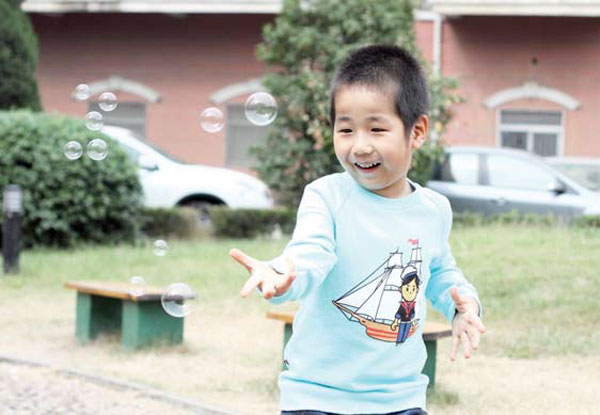Anguish, acceptance and love

Understanding, family support remain crucial for chinese children suffering from rare diseases
It has been three years, but Li Jia still remembers the day when she looked into her daughter's eyes and saw nothing.
"Her eyes wandered past me to focus, in an unfathomable gaze, on the motionless tree leaves outside our apartment window. There was no flame of excitement, no glint of curiosity, not even a faint glimmer of interest inside her dewy eyes, only the blurry outlines of the tree," recalled the mother, in a voice as calm as it was heart-rending.
| Above: A volunteer playing with children suffering from osteogenesis imperfecta; below: Wang Yuxuan, six-year-old son of Wang Wei, finds joy in life while putting up a tough fight against pulmonary arterial hypertension. Zhu Xingxin / China Daily |

"For a brief moment, I felt my heart had been hollowed out. I was totally scared."
What soon came after that fateful day was a discovery that dumped the whole family into turbulent waters. Li's daughter, An An, then only 16 months old, was diagnosed with Rett syndrome, a rare genetic neurological disorder that strikes one in every 15,000 people, predominantly females.
Symptoms are similar to those of autism in the disease's early stages. Although patients would gradually open up, in most cases, they would be unable to use their hands or feet, or develop any verbal skills, as a direct result of brain damage. Although patients in some developed countries can sometimes live into their 50s and 60s, in China, due to the lack of medical and social support, the majority don't survive beyond their 30s.
"It was excruciatingly painful - I cried my eyes out. But we persisted, living on a daily basis with all the mishaps and mayhem of the disease while keeping up hope for the best," says the 36-year-old. "In retrospect, any possible road leading to the future begins with acceptance, to accept the illness for what it really is. For a child patient, that acceptance starts being built with his or her family."
Yet that process can take years, according to Wei Min, a leading pediatrician with the Peking Union Medical College Hospital in Beijing. "Upon being told the bad news, some parents just collapse while others sit there, dumbfounded, seeing and hearing no more. But all eventually manage to recover from the initial shock to ask the same question: 'How could this be true'? And you know instinctively that no amount of medical knowledge would help here," Wei says. "Quite often, such denials are aided by the fact that rare diseases, by definition, are diseases that hit only a tiny segment of the population."
In the United States, the Rare Diseases Act of 2002 defines the term as any disease or condition that affects fewer that 200,000 people in the country, or about one in 1,500 people. In Japan, that ratio is set at about one in 2,500 people.
However, ratio alone could give the wrong impression, and in a country as populous as China, "tiny" means more than 15 million people, says Wei. "The 15 million figure often cited for China is a rough estimate at best, since we have no official definition for 'rare diseases' and have conducted no comprehensive census on the number of sufferers. Among them, nearly 70 percent are children."
Wang Yiou, founder of a Beijing-based non-governmental organization called China-Dolls Center for Rare Diseases, says she learned, in a way that deeply disturbed her, how the mind of a "rare kid" can be wrecked by refusing to accept reality.
"There was one time two years ago when we sent a copy of our monthly magazine to an address we believed to have belonged to a fellow patient. A few days later, we got a reply, in the form of a mail parcel, which contained a pair of scissors and a scribbling of words. It basically read: 'Dare to send me another copy and I'll commit suicide in front of you,'" she says. "A phone call soon followed, made by a lady who admitted to having subscribed to our magazine with the address. It was not meant for her son, who had brittle bone disease, but for herself and her husband, the heartbroken mother told us.
"She said, 'It kills my son to be reminded that he's a rare-disease patient. I don't know how he found the magazine, but please, don't send it ever again!'" Wang says. After enduring repeated bone fractures since he was a baby, the 32-year-old man was diagnosed at age 16 with osteogenesis imperfecta, also known as brittle bone disease. Hitting one per 20,000 live births, the congenital disease leaves its victims with defective or inadequate connective tissue, rendering them petite china dolls of small stature and fragile bones.
"Going by my own experience, the boy's denial of his own condition, and by extension himself, stemmed in large part from the evasiveness adopted by his entire family toward the disease. What was meant to be protection ended up to be harm," she says.
Zheng Yu, whose 15-year-old daughter, Gu Ruofan, first showed signs of a rare disease called mucopolysaccharidosis at kindergarten, believes that adults very often fail to correctly gauge the toughness of minors. Those with the disease do not produce adequate enzymes to break down certain sugar chains. Cellular damage results.
"My girl was diagnosed at 4, but we kept it from her for another four years, until 2007, when I took her to a symposium in Taiwan focused on the disease. We were sitting below while medical experts from around the world discussed its many symptoms including hindered growth, a thicker neck and unusable legs," says Zheng. "Suddenly, my daughter looked up at me and said, 'Mom, is this the same one that I've got?'
"'Are you OK?' I asked. 'Yeah ... I think I've been doing far better than many of them, right?' my daughter answered. And that was it," remembers the 41-year-old. "And then I knew I was the weak one."
If acknowledging the stark reality of a rare disease represents the first step forward, then what comes next should be to open up to the world, says Meng Yan, a genetic disease expert from the 301 Hospital in Beijing. And again, parents play a crucial role.
"Some Chinese parents are extremely reluctant to take their rare-disease children out, deterred by the popular misconception that a rare disease is 'genetic' and thus 'hereditary'," Meng says. "It's true that the overwhelming majority of the rare diseases are 'genetic', but it is more often than not due to a sporadic mutation of the genes. To put it simply, any perfectly healthy parent, including myself, stands the chance of giving birth to a 'rare child'."
"And such a child, especially those with conspicuous physical changes, draws confidence from his loved ones to face up to the inquisitive stares he or she is almost certain to encounter out on the streets. It's important to remember that parental love, however fierce and devoted it is, could never fill the void left in a child's heart by the lack of friends," she says.
"A 10-year-old could make another 10-year-old laugh in a way that no mother can," says Wang, whose NGO has been making headlines recently as a major beneficiary of donations coming from the Chinese version of the popular Ice Bucket Challenge campaign, started in the US. The campaign involves dumping ice water on someone's head to promote awareness of and raise money for research on rare diseases including amyotrophic lateral sclerosis - also called Lou Gehrig's disease after the famed US baseball player who died of it in 1941.
"A boy with brittle bone disease once showed me some deep scratches on the back of his hand. It turned out that this boy who has never said anything during our patients' meeting, is a professional eagle trainer. To me, the avidness with which he talked about his birds reveals a deeply hidden longing for human communication."
Gu says her daily walks from the classroom to the playground constitute both her happiest and saddest moments. "I'm the happiest when my best friend is at my side. But when we have a quarrel and she runs away, leaving me shuffling behind, dragging my legs, I'm the saddest," she says.
Children with rare diseases who have decided to "come out" are almost certain to suffer occasional emotional problems, says Zheng, who insists her daughter go to school. "It's worth it. For anyone, with or without a disease, respect is something to gained," she says. "If life's a battle, then I've put her on the frontline fighting for herself, while letting her know that I'm always here with her. Love is the best balm when there's a wound."
Yet no love should stand in the way of parents taking disciplinary actions against their "rare kids", says Zhao Ning, whose 8-year-old daughter was diagnosed with phenylketonuria or PKU, a metabolic genetic disorder, upon birth. Those with the disease lack an enzyme to break down an amino acid called phenylalanine.
"Patients should wean themselves of any 'normal food', and instead eat only 'synthesized food', which contains a much lower protein level yet tastes worse than starch. In many cases, parents relent after their kids plead repeatedly to have, say, a chocolate bar or simply a piece of meat. I'm the opposite of these parents," says the 40-year-old. "My daughter had once stolen some cakes from the kitchen. She was just about five or six, but I beat her hand hard with a stick," she says. "After that, I ran to my room and slapped ten times harder to my own face."
"The idea that your rare-disease child needs to take no responsibility for his or her health is a myth, and encourages nothing but self-pity," says Zhao, whose daughter, apart from attending regular schools, has learned to play music and even swim. "It's up to parents to instill in their kids a strong sense of regimen, which they then need to plan their lives around their disease."
In January, Li Jia gave birth to her second daughter, Jia Jia. "She's a healthy baby, having learned to crawl at five months old," the mother says. "I understand all the concerns a 'rare parent' has in not having another child, but my little one is working miracles on her elder sister.
"Due to her illness, An An is slow in her reactions. There's this time when Jia Jia called out to her sister, making a prolonged 'Ah...' sound while waiting for her reply. This lasted for about half a minute, until An An finally looked up from her seemingly unstoppable hand-wringing," says Li. "The moment was so touching - none of us adults had ever given An An that much time as her little sister."
And it's a moment that anchors Li's life. "When An An was first diagnosed, I thought I was going to live with her and watch her die. Now I see things differently," she says. "Being unable to use her hand or speak her mind, An An is experiencing immense frustration every single second. The bravery she has shown is inspiring to all of us. She's a blessing in disguise."
Wei, the pediatrician, says she can't emphasize enough the role of family, especially parents, in the physical and mental well-being of a rare child.
"Worldwide, nearly 7,000 different types of rare diseases have been identified. For the overwhelming majority of them, no cure exists or is likely to be found in the near future," she says. "If anything, the stark reality has made it more crucial for parents to remember that your rare child has a life to explore, whatever its length. They are responsible for laying the very first brick for the bridge of understanding between a rare kid and his disease, between him and the rest of the world."
Wang Wei, father of a six-year-old who suffers pulmonary arterial hypertension, sees that bridge as "a rainbow that links my rare-disease son with his sweetest dreams. "The high blood pressure inside his lungs has been making it hard for him to breathe, especially at night," says the father. "But from time to time, we would drive him to the seaside for a fun day. And on that particularly night, he would sleep so soundly, woken up only occasionally by his own laughter."
Such efforts will never go unappreciated, says Li. "Sometimes, An An would give me a lick on the face, which is her way to plant a kiss. Other times, she'll just nuzzle up toward me, like a little cub, and the tiny sound from her nostrils assures me that she's comfortable and contented," she says.
Early this year, Li got an email from the mother of another Rett child from overseas. "She wrote about communicating with her brain-damaged daughter with the help of an eye-tracking machine that interprets a person's gestures and signals by capturing the movements of his or her eyeballs," says Li. "At the end of the conversation, the screen came up with these words: 'Mom, I love you.'"
zhaoxu@chinadaily.com.cn
| An An, 4, kisses her sister Jia Jia. An An was diagnosed with Rett syndrome when she was 16 months old. Provided to China Daily |
(China Daily Africa Weekly 09/19/2014 page24)
Today's Top News
- HK's Jimmy Lai convicted in national security case
- China announces countermeasures against former Japanese senior official
- Australia set to further tighten gun control laws
- HKSAR security chief on conviction of Jimmy Lai
- Jimmy Lai's verdict sends clear messages
- Japanese scholar condemns Japan's risky defense spending
































